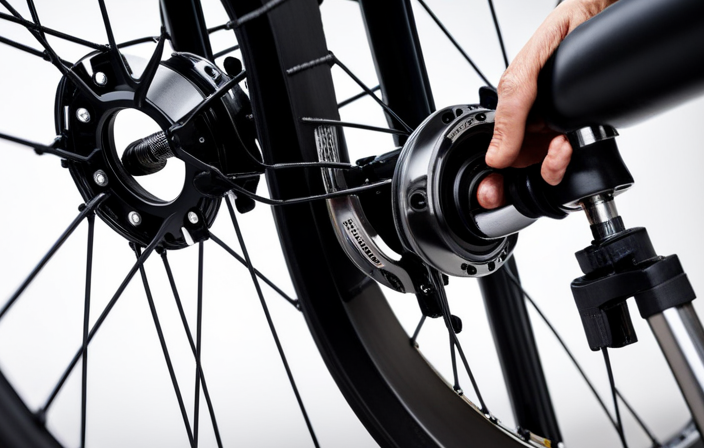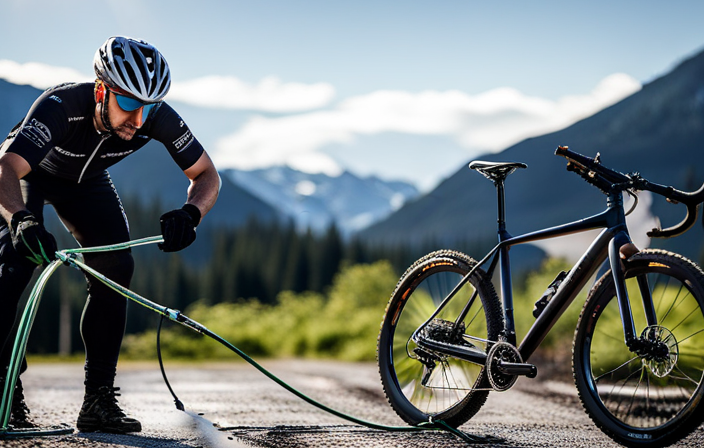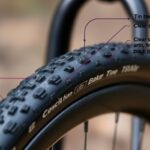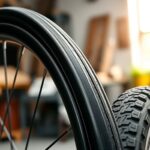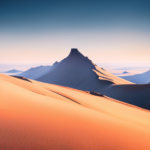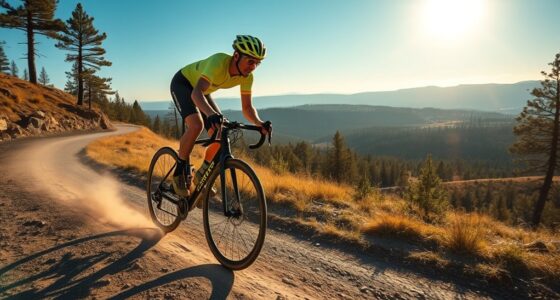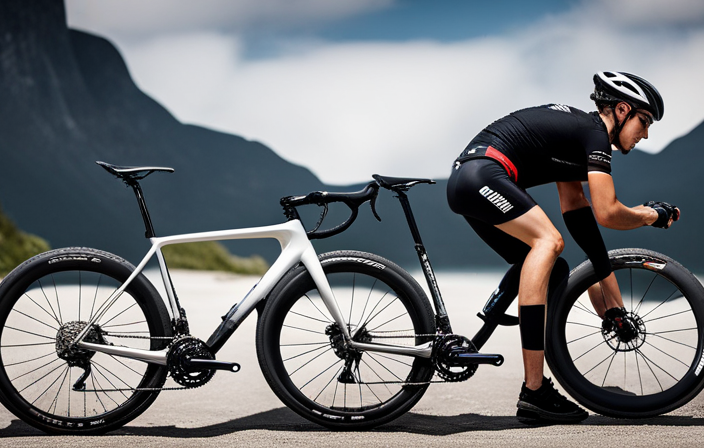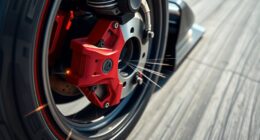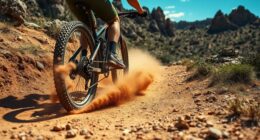Imagine riding along a dusty gravel path, feeling the breeze against your hair and the excitement of exploration pulsing through you. Out of nowhere, you’re met with the dreaded hiss of a tire deflating. A wave of disappointment washes over you as you understand that this flat tire might just halt your adventurous journey.
But what if I told you there was a way to minimize the risk of flats and enjoy a smoother, more reliable ride? Going tubeless on your gravel bike could be the answer you’ve been searching for.
In this article, I’ll guide you through the process of going tubeless step-by-step, so you can experience the freedom and confidence that comes with this innovative setup. Get ready for a journey that will transform your gravel riding experience like never before!
Key Takeaways
- Going tubeless on a gravel bike provides a smoother ride with lower tire pressures, increasing traction and control on rough terrain.
- Tubeless setup reduces the risk of punctures and pinch flats, with automatic sealing of small holes for improved off-road performance.
- The necessary tools for tubeless conversion include tubeless tire sealant, tubeless-ready rims, tubeless valves, tire levers, and an air compressor or floor pump.
- The process of converting to tubeless involves removing existing tubes and tires, cleaning and prepping the rim and tire, installing tubeless rim tape and valves, and mounting tubeless tires with the correct sealant. Regular maintenance and replenishing of sealant is also important for optimal performance.
Understand the Benefits of Going Tubeless
You’ll love the benefits of going tubeless on your gravel bike. Tubeless tires have become increasingly popular in the cycling world, and for good reason. The advantages of tubeless over tubular are numerous.
First and foremost, tubeless tires provide a smoother ride by allowing you to run lower tire pressures without the risk of pinch flats. This means better traction and control on rough off-road terrain.
Additionally, tubeless setups are more resistant to punctures, as there is no inner tube to be pinched or popped by sharp objects. Off-road riding can be unpredictable, with rocks, thorns, and other hazards posing potential threats to your tires. By going tubeless, you significantly reduce the chances of getting a flat tire during your adventures.
Furthermore, if you do encounter a puncture while riding tubeless, the sealant inside the tire will often seal up small holes automatically.
To fully enjoy these benefits, it’s important to gather the necessary tools and equipment for converting your bike to a tubeless setup.
Gather the Necessary Tools and Equipment
First, gather all the tools and equipment needed for the conversion. To successfully go tubeless on a gravel bike, you will need a few key items. Here is a table outlining the necessary tools and equipment:
| Tools | Equipment |
|---|---|
| Tubeless tire sealant | Tubeless-ready rims |
| Tubeless valves | Tire levers |
| Air compressor or floor pump | Rim tape |
| Valve core remover tool | Tire sealant injector or syringe |
The benefits of using tubeless on road bikes are numerous. Firstly, it reduces the risk of punctures caused by pinch flats or small debris. The sealant inside the tires quickly seals any small holes, allowing you to continue riding without interruption. Additionally, going tubeless allows you to run lower tire pressures for improved comfort and traction on rough surfaces.
Once you have gathered all the necessary tools and equipment, it’s time to remove the existing tubes and tires. [Transition sentence into subsequent section: With everything prepared, removing the existing tubes and tires is the next step in achieving a successful tubeless conversion.]
Remove the Existing Tubes and Tires
Now that I have all the necessary tools and equipment, it’s time to remove the existing tubes and tires from my bike.
Before starting this process, it’s important to understand how tubeless setups work. Tubeless tires rely on an airtight seal between the tire and rim to hold air without the need for an inner tube. This allows for lower tire pressures, better traction, and fewer flats.
To begin, I deflate the tires completely by removing the valve cores using a valve core remover tool. Once deflated, I release any remaining air pressure by pressing down on the tire with my hands.
Next, I use tire levers to carefully pry one side of the tire off the rim, working my way around until it is completely removed. It’s crucial to avoid damaging either the rim or tire during this process.
When choosing new tubeless tires, consider factors such as terrain type, desired tread pattern, and durability. Ensure that they are compatible with your rims and have proper sidewall strength for gravel riding.
With the tubes and old tires removed, I can now move on to cleaning and prepping both the rim and tire for installation of new tubeless components without causing any damage in order to ensure a successful setup.
Clean and Prep the Rim and Tire
To properly set up a tubeless tire, it’s important to thoroughly clean and prepare both the rim and tire. This step is crucial for ensuring a secure seal and optimal performance.
First, I start by removing any dirt, debris, or old adhesive tape from the rim using a soft brush or cloth. This ensures that the rim surface is clean and free of any obstructions that could interfere with the sealing process.
Next, I move on to cleaning the tire itself. I use warm soapy water and a scrub brush to remove any dirt or residue that may have accumulated on the inner surface. It’s important to pay extra attention to areas around the bead where the tire will make contact with the rim.
Once both the rim and tire are clean, it’s time to choose the right tire sealant. There are various options available in the market, but I prefer a latex-based sealant as it provides excellent sealing properties and can easily seal small punctures on-the-go.
With a clean rim and prepared tire, we can now move on to installing tubeless rim tape without any issues.
Install Tubeless Rim Tape
You’ll want to make sure you have the correct width of rim tape for your specific wheel before starting the installation process. Tubeless rim tape is an essential component when converting a gravel bike to tubeless. Its primary function is to create an airtight seal between the rim and tire, preventing air from escaping. There are different types of tubeless rim tapes available, such as vinyl or cloth-based options. It’s important to choose a tape that matches the width of your rim for optimal performance.
To successfully install tubeless rim tape, start by thoroughly cleaning the rim surface and removing any dirt or debris. Next, begin applying the tape evenly around the circumference of the rim, making sure it covers all spoke holes completely. It’s crucial to stretch and press down firmly on the tape as you go to ensure proper adhesion.
When finishing up, trim any excess tape neatly with scissors or a sharp blade. This step helps prevent any interference with other components like valves or tires.
With your tubeless rim tape securely in place, you’re now ready for the next step: installing tubeless valves. These valves play a vital role in allowing air into and out of the tire when setting up your gravel bike tubelessly.
Install Tubeless Valves
Once the rim tape is securely in place, it’s time to install the tubeless valves. Tubeless valve installation is a crucial step in converting your gravel bike to a tubeless setup. These valves play a key role in allowing air to enter and exit the tire while maintaining an airtight seal.
To begin, gather all the necessary tools: tubeless valves, valve cores, valve nuts, and a valve core removal tool. Start by removing the valve core from each valve using the removal tool. This allows for easy inflation of the tire later on.
Next, insert one tubeless valve through each rim hole from inside to outside. Secure them in place by tightening the valve nut onto the outer side of the rim. Ensure that they are snug but not overly tight to avoid damaging the rim.
Now that you have installed your tubeless valves, it’s important to choose the right sealant for optimal performance. The type and amount of sealant depend on factors such as tire size and riding conditions. Consult with your local bike shop or manufacturer’s recommendations for guidance.
Incorporate this table for reference:
| Tube Size | Recommended Sealant Amount |
|---|---|
| 700c | 50-60ml |
| 650b | 40-50ml |
| Others | Varies |
Choosing the appropriate sealant will help prevent punctures and maintain proper tire pressure over time.
With your tubeless valves properly installed and sealant chosen, you’re now ready to mount your tubeless tires onto your gravel bike.
Transition into subsequent section: "Now that we have our valves installed and sealant chosen, let’s move on to mounting our tubeless tires."
Mount the Tubeless Tires
After properly installing the tubeless valves and choosing the right sealant, it’s time to mount your tubeless tires. Tubeless tire installation can be a bit tricky at first, but with practice, it becomes easier.
Start by deflating your tire completely and removing the valve core. This will allow for easy inflation later on. Next, line up one of the tire beads with the rim edge and start working it onto the rim using your hands or tire levers if needed. Once one side is on, move to the other side and repeat the process.
Tubeless tires offer several benefits over traditional clincher tires. They eliminate pinch flats since there is no inner tube to pinch between the rim and tire during impact. This allows riders to run lower tire pressures for increased traction and comfort without worrying about flatting out. Additionally, tubeless setups often provide a smoother ride due to decreased rolling resistance.
Now that you have successfully mounted your tubeless tires, it’s time to add sealant to ensure a proper seal between the tire and rim.
Add Sealant to the Tires
To ensure a proper seal between the tire and rim, it’s time to add some sealant to the tires.
Using sealant for tubeless tires offers numerous advantages that every gravel bike rider should consider. Firstly, sealant helps prevent punctures by quickly sealing any small holes or cuts in the tire while you ride. This means you can confidently tackle rough terrain without worrying about getting stranded with a flat tire.
Additionally, sealant also helps maintain tire pressure by sealing any air leaks through the sidewalls or around the bead of the tire. This not only improves your overall riding experience but also ensures optimal performance on different surfaces.
When choosing a sealant for your gravel bike tires, there are a few factors to consider. Look for a sealant that is compatible with both your tire and rim materials to avoid any chemical reactions that could damage them. It’s also important to choose a sealant with good longevity, as this will save you from constantly adding more throughout your rides.
With the right sealant chosen, it’s time to move on to inflating and seating the tires properly, ensuring they are securely in place for your next adventure.
Inflate and Seat the Tires
Now it’s time to inflate and seat the tires properly for a secure ride. Before you start, make sure you have a tubeless-compatible pump or an air compressor with a high-pressure gauge.
Begin by removing the valve core using a valve core remover tool. This will allow for faster and easier inflation.
To inflate the tires, attach the pump or air compressor to the valve stem. Pump in short bursts of air to avoid overinflating and causing damage. Keep an eye on the pressure gauge and aim for your desired tire pressure, which is usually indicated on the side of the tire or recommended by the manufacturer.
As you inflate, listen carefully for any popping sounds that indicate the tire seating onto the rim bead. If you don’t hear any pops, give the tire a firm squeeze around its circumference to help it seat properly.
Once inflated, check if both sides of each tire are evenly seated against the rim bead. You can do this by inspecting visually or running your fingers along both sides. If there are any areas that appear unseated, deflate slightly and repeat the process until they are fully seated.
With your tires properly inflated and seated, it’s time to move on to checking for leaks and sealing any holes that may be present in order to ensure an airtight setup.
Check for Leaks and Seal any Holes
First, make sure to inspect your tires for any leaks and seal them if necessary. Checking for leaks is an essential step in maintaining tubeless tires on your gravel bike. To do this, I recommend using a soapy water solution and applying it to the tire’s surface. Look for bubbles forming, as they indicate air escaping from a hole or puncture. Once you locate the leak, use a tire plug or adhesive patch to seal it up securely.
To help you troubleshoot common issues and keep your tubeless setup in tip-top shape, I’ve created a handy table below:
| Common Issue | Solution |
|---|---|
| Persistent leaking around valve stem | Reinstall valve core with fresh sealant or replace the valve stem altogether |
| Sidewall seeping air | Apply a thin layer of sealant along the affected area and allow it to cure |
| Sealant drying out too quickly | Maintain and replenish sealant regularly according to manufacturer recommendations |
After addressing any leaks or holes, it’s crucial to test ride your gravel bike to ensure everything is properly sealed. During this test ride, pay attention to any unusual sounds or loss of pressure. If needed, adjust the tire pressure accordingly.
In conclusion, checking for leaks and sealing any holes are essential steps in maintaining tubeless tires on your gravel bike. By following these guidelines and troubleshooting common issues as needed, you can enjoy a smooth and hassle-free riding experience. Now let’s move on to fine-tuning tire pressure for optimal performance.
Fine-Tune Tire Pressure
Once you’ve sealed any leaks and holes, it’s time to fine-tune the tire pressure on your ride for optimal performance. Adjusting tire pressure is crucial to optimize the performance of tubeless gravel bike tires. Here are some key points to keep in mind:
-
Start with a baseline: Begin by inflating your tires to the manufacturer’s recommended pressure range. This will give you a starting point to work from.
-
Consider terrain and conditions: Depending on the type of surface you’ll be riding on, adjusting tire pressure can greatly enhance your ride. Lower pressures provide better grip and traction on loose or muddy surfaces, while higher pressures are ideal for smooth or hard-packed roads.
-
Experiment and find your sweet spot: It’s important to experiment with different pressures during your rides. Gradually increase or decrease the pressure in small increments until you find what feels best for your specific bike, weight, and riding style.
-
Pay attention to feedback: Listen to how your bike feels as you ride. If you notice excessive bouncing or bottoming out, consider increasing the pressure slightly. Conversely, if you feel like there’s not enough traction or comfort, try reducing the pressure.
-
Regularly check and adjust: Tire pressure can fluctuate over time due to temperature changes or gradual air loss. Make it a habit to regularly check and adjust your tire pressure before each ride.
By fine-tuning your tire pressure, you’ll ensure optimal performance during every adventure on your tubeless gravel bike.
Now let’s move on to testing our setup on a ride and making any necessary adjustments along the way.
Test Ride and Adjust as Needed
To optimize your tire performance, take your bike for a test ride and make any necessary adjustments along the way. When embarking on a test ride, it’s important to pay attention to how the tires feel and respond on different surfaces. Start by riding on familiar terrain, such as pavement or hard-packed gravel, to get a baseline understanding of the tire’s performance. Pay close attention to how the bike handles corners, accelerates, and brakes.
During the test ride, be mindful of any issues that may arise. If you notice excessive bouncing or loss of traction, it could indicate that the tire pressure needs adjustment. Decrease or increase the pressure in small increments until you find the sweet spot where your bike feels stable and grips well.
Additionally, keep an eye out for any leaks or punctures during the test ride. If you experience repeated flats or air loss, it may be necessary to inspect and reseal the tire using sealant.
By conducting a thorough test ride and troubleshooting any issues that arise, you can ensure optimal tubeless performance for your gravel bike. Remember to maintain and replenish sealant regularly to prolong tire longevity and prevent potential problems down the road.
Maintain and Replenish Sealant Regularly
Make sure you regularly maintain and replenish the sealant to keep your tires in optimal condition. Replenishing sealant is a crucial part of tubeless setup maintenance, as it helps prevent air leaks and punctures.
To start, remove the valve core using a valve core remover tool and add an appropriate amount of fresh sealant. The recommended amount typically depends on tire size, so refer to the manufacturer’s guidelines for accurate measurements.
After replenishing the sealant, make sure to thoroughly shake the tire to evenly distribute it inside. This will ensure maximum coverage and effectiveness against potential punctures. It’s also essential to periodically check the sealant level by spinning the wheel and listening for any sloshing sounds – if there is minimal or no sound at all, it might be time for another top-up.
Troubleshooting sealant issues can involve dealing with clogged valves or dried-out sealant. If you encounter clogs, use a small wire or pin to clear them before adding more sealant. In case of dried-out sealant, simply remove the old one and replace it with fresh liquid.
Maintaining proper levels of sealant is vital to ensure reliable tubeless performance on gravel rides. With regular maintenance and timely replenishment, you can avoid common issues that may arise during your adventures off-road.
Troubleshoot Common Issues
If you encounter any issues, troubleshooting common problems with your tire sealant is essential for a smooth and hassle-free ride. Here are some tips to help you troubleshoot common issues and prevent tire burping:
-
Check the seal: One common issue is a poor seal between the tire bead and rim. To fix this, deflate the tire completely, remove it from the rim, clean both surfaces thoroughly, and re-seat the tire ensuring proper alignment. This will create a tight seal and prevent air leaks.
-
Inspect for damage: Regularly inspect your tires for cuts, punctures, or other damage that could compromise their integrity. If you notice any issues, patch or replace the damaged area before adding more sealant.
-
Adjust air pressure: Incorrect air pressure can lead to burping or loss of sealant effectiveness. Experiment with different pressures to find the optimal balance between grip and preventing burping.
By following these troubleshooting steps and taking preventive measures, you can minimize common issues like poor seals and prevent tire burping.
With these tips in mind, enjoy a smooth and puncture-free ride!
Enjoy a Smooth and Puncture-Free Ride!
With proper maintenance and attention to tire condition, you can experience a ride that is free from bumps and punctures. One of the main benefits of tubeless tires is their ability to provide a smoother ride on gravel terrain. The absence of an inner tube allows for lower tire pressure, which increases traction and absorbs shocks from uneven surfaces. This means you can tackle rough trails with confidence, knowing that your tires will grip the ground and keep you stable.
However, even with tubeless setups, there can be occasional issues that may disrupt your smooth ride. One common problem is sealant leakage or drying out over time. To troubleshoot this, regularly check the sealant levels in your tires and add more if necessary. Additionally, inspect the tire sidewalls for any cuts or tears that could compromise the seal.
Another potential issue is burping or losing air pressure while riding at high speeds on rough terrain. This can usually be resolved by ensuring that your tires are properly seated on the rim and sealed tightly. It’s also important to maintain an appropriate tire pressure for your weight and riding style.
By following these troubleshooting tips and maintaining your tubeless setup, you can enjoy a smooth and puncture-free ride on your gravel bike. So get out there, explore new trails, and embrace the freedom of going tubeless!
Frequently Asked Questions
How long does it typically take to convert a gravel bike to tubeless?
Converting a gravel bike to tubeless usually takes about an hour or two.
The process involves gathering a few essential tools and materials, such as tubeless-ready tires, rim tape, sealant, tire levers, and an air compressor or floor pump with a high-pressure gauge.
Starting with cleaning the rims and installing the rim tape, then mounting the tubeless-ready tires before adding sealant and inflating them.
It’s important to follow manufacturer instructions for specific details.
Can I use any type of tire with a tubeless setup?
Yes, you can use different types of tires with a tubeless setup on your gravel bike. One interesting statistic is that tubeless tire setups offer lower rolling resistance compared to traditional clincher tires. This means more efficiency and speed on the road or trail.
When choosing the best tubeless tire options, consider factors like tread pattern, durability, and puncture resistance. Popular choices include the Schwalbe G-One Allround, WTB Riddler, and Maxxis Rambler.
What is the recommended amount of sealant to add to each tire?
When it comes to adding sealant to each tire in a tubeless setup, the recommended amount varies depending on the size of your tires. As a general guideline, I suggest using 2-4 ounces of sealant per tire for gravel bikes. This ensures proper coverage and protection against small punctures.
The benefits of a tubeless setup include improved traction, lower rolling resistance, and the ability to run lower tire pressures for better comfort on rough terrain.
Do I need to carry a spare tube in case of a major puncture?
Yes, it’s highly recommended to carry a spare tube even with a tubeless setup.
While the benefits of going tubeless on a gravel bike include reduced flats and improved ride quality, there is still a possibility of major punctures that sealant cannot fix.
Carrying a spare tube ensures that you have a backup option in case of such emergencies, allowing you to quickly get back on the road or trail without any delays.
How often should I check for leaks and replenish the sealant?
I check for leaks and replenish the sealant in my tubeless gravel bike on a regular basis to ensure optimal performance. It is recommended to check for leaks every 2-4 weeks, depending on your riding conditions and mileage.
When replenishing the sealant, I follow best practices by removing the valve core, injecting fresh sealant through the valve, and rotating the wheel to distribute it evenly. This helps maintain a reliable tubeless setup and prevents punctures from becoming major issues.
Conclusion
In conclusion, going tubeless on your gravel bike is like embarking on a transformative journey. It’s like shedding the heavy armor of tubes and embracing the freedom of weightlessness.
With the right tools and equipment, you can effortlessly glide over rugged terrains without fear of punctures. By maintaining and replenishing sealant regularly, you ensure that your ride remains smooth and uninterrupted.
So, take the leap into tubeless paradise and experience the joy of a puncture-free adventure on two wheels!
